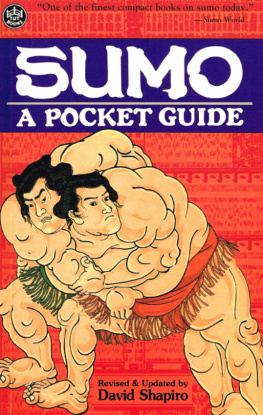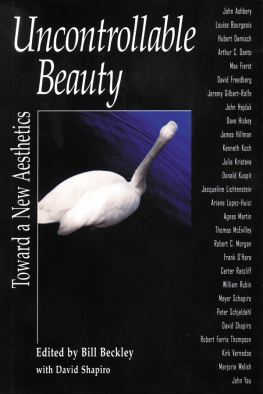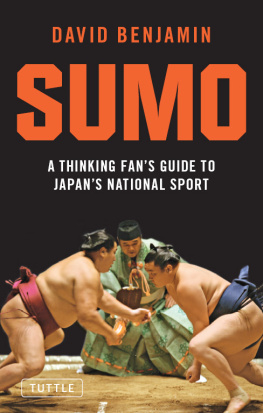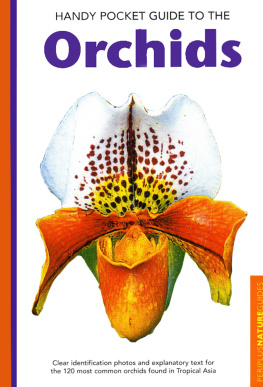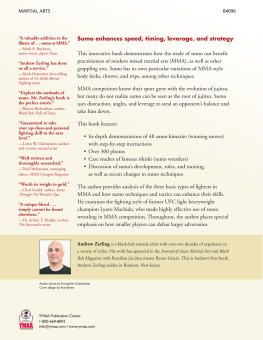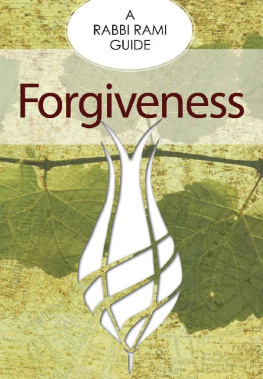David Shapiro - Sumo a Pocket Guide
Here you can read online David Shapiro - Sumo a Pocket Guide full text of the book (entire story) in english for free. Download pdf and epub, get meaning, cover and reviews about this ebook. publisher: Tuttle Publishing, genre: Home and family. Description of the work, (preface) as well as reviews are available. Best literature library LitArk.com created for fans of good reading and offers a wide selection of genres:
Romance novel
Science fiction
Adventure
Detective
Science
History
Home and family
Prose
Art
Politics
Computer
Non-fiction
Religion
Business
Children
Humor
Choose a favorite category and find really read worthwhile books. Enjoy immersion in the world of imagination, feel the emotions of the characters or learn something new for yourself, make an fascinating discovery.
- Book:Sumo a Pocket Guide
- Author:
- Publisher:Tuttle Publishing
- Genre:
- Rating:5 / 5
- Favourites:Add to favourites
- Your mark:
- 100
- 1
- 2
- 3
- 4
- 5
Sumo a Pocket Guide: summary, description and annotation
We offer to read an annotation, description, summary or preface (depends on what the author of the book "Sumo a Pocket Guide" wrote himself). If you haven't found the necessary information about the book — write in the comments, we will try to find it.
Sumo a Pocket Guide — read online for free the complete book (whole text) full work
Below is the text of the book, divided by pages. System saving the place of the last page read, allows you to conveniently read the book "Sumo a Pocket Guide" online for free, without having to search again every time where you left off. Put a bookmark, and you can go to the page where you finished reading at any time.
Font size:
Interval:
Bookmark:

Chankonabe Restaurants
When in Tokyo, a real dining treat is a visit to one of the several restaurants that specialize in chanko-nabe, that one-pot sumo staple on every stable's menu. Although the Japanese prefer to eat this dish in winter, it is designed to be eaten all year long. Filled with meat, chicken, or fish and an assortment of vegetables, it is as nutritious as it is delicious. The sampling of restaurants listed below is guaranteed to add a new dimension to your sumo experience. And don't forget to call ahead, in Japanese, for reservations.
ICHINOTANI
2-10-2 Soto Kanda
Chiyoda-ku, Tokyo 101
Tel. (03) 3251-8500
HAMARIKI
2-14-5 Takadanobaba
Shinjuku-ku, Tokyo 169
Tel. (03) 3200-2901
KAWASAKI
2-13-1 Ryogoku
Sumida-ku, Tokyo 130
Tel. (03) 3631-2529
NARUYAMA
3-9-2 Kudan Minami
Chiyoda-ku, Tokyo 102
Tel. (03) 3261-1632
DAIKIRIN
1-1-11 Nezu
Bunkyo-ku, Tokyo 113
Tel. (03) 3823-5998
KIYOKUNI
2-14-23 Koishikawa
Bunkyo-ku, Tokyo 112
Tel. (03) 3816-5544
KITASEUMI
1-21-22 Nishi Koiwa
Edogawa-ku, Tokyo 133
Tel. (03) 3672-7393
TOMOEGATA
2-17-6 Ryogoku
Sumida-ku, Tokyo 130
Tel. (03) 3632-5600
TAMAKATSU
3-2-12 Negishi
Taito-ku, Tokyo 110
Tel. (03) 3872-8712
YOSHIBA
4-8-11 Ginza
Chuo-ku, Tokyo 104
Tel. (03) 3567-4481
IZUTSU
4-18-8 Shimbashi
Minato-ku, Tokyo 105
Tel. (03) 3434-5557
FURIWAKE
3-35-13 Yushima
Bunkyo-ku, Tokyo 113
Tel. (03) 3836-5888
CHAPTER 1

As Old as the Nation
Wrestling seems to have been around almost as long as a civilized mankind has. You can find it in most every culture in one form or another. The fact that there are only so many different ways in which you can grapple with an opponent guarantees that similar styles of wrestling will develop in completely unrelated cultures. This holds true for Japan's national sport, sumo, as well. You can find sumo-like sports in places as far apart as Egypt, Senegal. and Switzerland.
In Japan's case, the sport is as old as the nation itself, appearing in the country's creation mythology. This does not mean that it developed uninfluenced by outside forces. Japan's close ties to ancient China and the various kingdoms of what became known as the Korean peninsula ensured that there would be some impact of their versions of the sport on this country's brand of wrestling. However, sumo is generally considered to be one of the two truly indigenous aspects of Japanese culture, along with the Shinto religion to which it is closely tied. In fact, sumo finds its roots firmly planted in the soil of this ancient faith.
Shinto is an animistic religion closely tied to Japanese rice culture. It is filled with a pantheon of deities, and the Japanese imperial line traces its origins to the most powerful of them. Sumo as a religious function is referred to as shinji-zumo and it can still be found today as part of festival activities held at many Shinto shrines around the country. At the time of its origin, it was closely tied to the Japanese rice culture. Matches were performed at a local shrine to determine how good or bad a given harvest would be. As the national polity began to take shape under the suzerainty, or overlordship, of the imperial household, these matches were performed before the ruling emperor or empress to determine the outcome of the country's harvest, thus making shinji-zumo an event of national importance. By the Nara period (646-794) this had become an annual court event.
The next incarnation in sumo's long journey to what it has become today took place during the Heian period (794-1185). While it was still being practiced primarily as a religious service related to the rice harvest and, by this time, as an offering to the gods to obtain their protection of the nation, it was also performed as a court entertainment called sumai no sechie. This new usage of sumo as entertainment was an important step toward it becoming a sport.
These events were held to mark the changes of season and became national affairs with scouts being sent out across the land to find the most powerful competitors the country had to offer. Many of the best wrestlers of the day were farmers by trade. Since these court-organized competitions were held at some of the busiest times of the year down on the farm, it was not uncommon for a competitor to enter the capital city of Kyoto hog-tied and at swordpoint. In spite of this press-gang approach to recruiting, sumo's ties to the highly formalized lifestyle of the Heian court, coupled with its religious origins, would lead it to develop into a sport steeped in ritual.
The passing of the Heian period saw an end to the political control of the nation by the imperial court and, as such, its influence on the development of sumo. The Kamakura period (1185-1336) saw the beginning of the rule of the samurai, who embraced sumo with enthusiasm. To them, it was a perfect form of hand-to-hand combat as well as an excellent training tool. They did not ignore sumo's entertainment value though, and regularly held competitions as a way of passing the time between battles.
The loss of political influence by the imperial court also led to an equal decline in its wealth. One of the things that suffered as a result of this was the court's ability to hold spectacular ceremonial events on a grand scale, including sumai no sechie. Although shinji-zumo events were still being held at the grassroots level and the samurai were also practicing sumo on a regular basis, this turn of events led to a three hundred-odd year slump for sumo on the national stage. It was still a part of Japanese life, but no one was holding sumo tournaments with the same kind of national significance as those held by the Heian court.
All this was to change with the rise to power of the first great shogun, Oda Nobunaga. A rough-and-tumble kind of guy who climbed up the ranks from fairly humble beginnings, Nobunaga liked his entertainment on the working-class side. One of his favorite pastimes was, naturally, sumo. In 1578 he gathered fifteen hundred men from across the land for a major one-day sumo competition. Sumo was once again a national pastime with what was to become regular performances before the powers that be.
During that protracted downturn in sumo's fortunes as a government-supported entity, it was evolving once again, this time on the local level. It was then, during the Muromachi period (1336-1568), that sumo took one more major step toward becoming a professional sport with the development of something called kanjin-zumo. These events involved bouts designed to raise money for improvements or repairs to the many temples and shrines that dotted the nation. The Muromachi period also saw the beginnings of professional sumo wrestlers, masterless samurai who banded together into troupes wandering the countryside to participate in kanjin-zumo events. These groups would usually receive a percentage of the gate and there was always cash and prizes available for the top competitors.
By the Tokugawa period (1603-1868), kanjin-zumo was becoming more professional and less charitable. This 268-year period, known in some sources as "The Pax Tokugawa," brought more than two centuries of peace and prosperity to the nation. With the rise of Ieyasu, the first Tokugawa shogun, the constant warring between various feudal lords was put to an end. As a result, even more warriors found themselves out of work, expanding the ranks of the wandering professional wrestlers.
Font size:
Interval:
Bookmark:
Similar books «Sumo a Pocket Guide»
Look at similar books to Sumo a Pocket Guide. We have selected literature similar in name and meaning in the hope of providing readers with more options to find new, interesting, not yet read works.
Discussion, reviews of the book Sumo a Pocket Guide and just readers' own opinions. Leave your comments, write what you think about the work, its meaning or the main characters. Specify what exactly you liked and what you didn't like, and why you think so.

